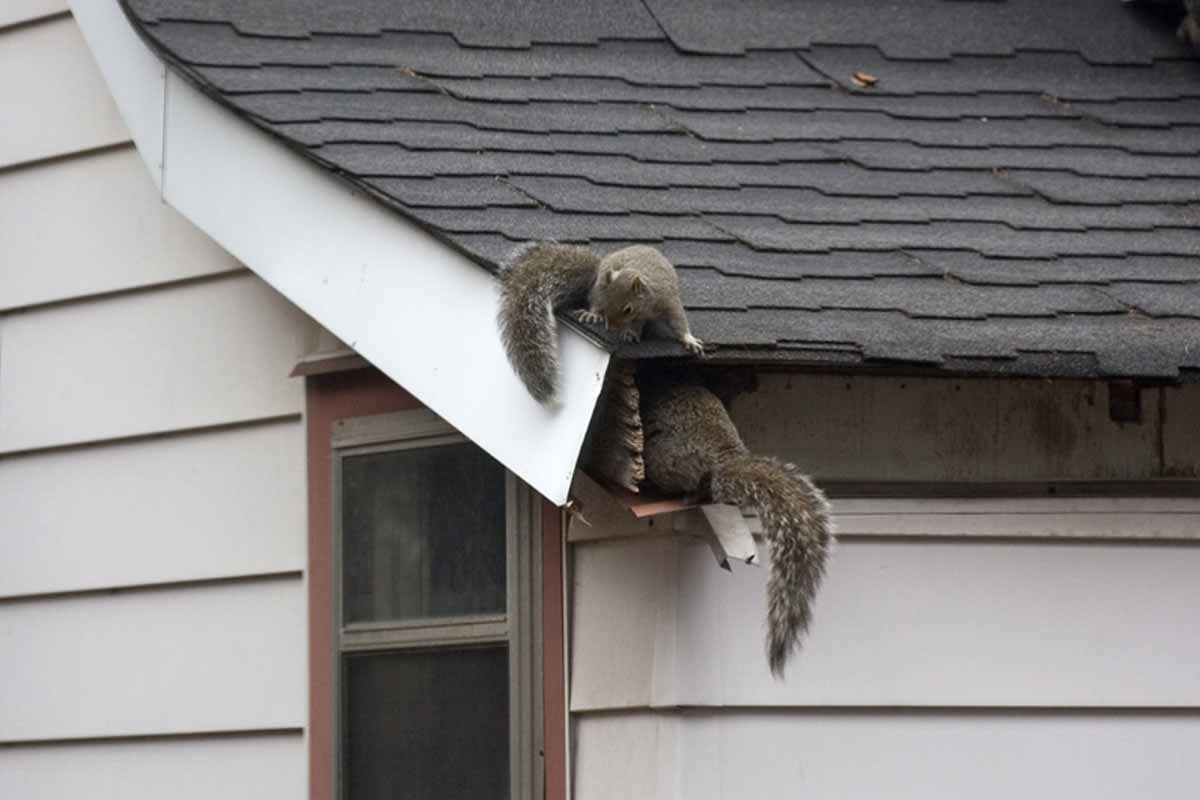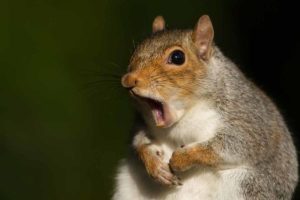Squirrels in the Attic
14 min read Updated for March, 2019
Squirrels can be fun to watch scamper around the park, or even our backyard, but we don’t want them running around in our attic. Unfortunately, it happens. And in addition to being loud, they can tear up everything in their path. Their teeth never stop growing, so they will gnaw their way through your wiring, insulation, wood beams and all those things you’re storing and keeping.
Squirrel Problem?
Squirrel Sounds
Squirrels are VERY vocal in communicating with one another, from chattering and chirping, to grunts and squeaks, to foot stomping and shrieking. Of course, non-verbal sounds—especially if they are in your attic and walls—include scratching, scraping, gnawing, and scurrying.
Squirrel Tracks
As a rodent, squirrels have five toes on both their front and hind paws with smaller front paws than hind. Their front paws are roughly half-inch by half-inch, the hind are longer—about an inch long and half-inch wide. In addition to the five clawed toes, they have several pads so some tracks may look like several little spots in addition to the toes. Tracks in mud or snow though, look more like handprints. Squirrels are also ‘bounders’ in their gait so tracks are often a foot or two apart.
Squirrel Poop
Squirrel droppings are usually small brown pellets about a half inch in length, with rounded ends, a little larger than rat droppings. Depending on species, they’ll be close in size to a jellybean, raisin, or pill. You’ll also find their poop in close proximity to the entrance they use to get into your home.
Signs of Squirrels in the Attic
The best way to know if a squirrel has taken up residence in your attic is the noise. They are loud little creatures which you can hear scratching, chewing or rustling around. They forage for food during the day and nest in the morning and evenings, so those are the times you are most likely to hear them.
You’re likely to see their droppings, but you may smell them first. Their droppings, urine, and the nest they build will give off a musty or stale odor. And squirrels make a mess. In the wild, they build their nests using twigs, leaves, and vines. If they’re using your attic as home base, they’ll either drag these things in from outside or use things in your attic to build their nest. The nests are usually a fairly good size, so they’re easy to spot and know if a squirrel is making your house its home.
If there are a lot of squirrels in or around your property, this is another good indicator. If you catch them running along utility lines, your roof or fence, you will want to check the attic. But even if they haven’t gotten inside yet, they may have already caused damage—chewing on your siding or roof vents.

How Did They Get There?
Like most animals, squirrels are looking for a safe place to build a nest and raise their young. Development has forced squirrels out of their natural habitats, and attics are warmer than the outside and offer far more protection than the trees in your yard. Squirrels can squeeze through small spaces, so it’s important to do regular, routine inspection and maintenance on your home to make sure there are no holes or openings.
If you have soft, rotting or unpainted wood, it can create a weak point and make it easy for them.
Because of their sharp teeth and constant chewing, squirrels can make their own entry point into your home. If you have soft, rotting or unpainted wood, it can create a weak point and make it easy for them. Roof vents, edges, and soffits are all places squirrels can chew through. The plastic and aluminum vent covers are no match for their strong jaws and sharp teeth. If you have deteriorating shingles or roof boards, those can also provide easy access, as well as where two parts of the roof meet and shingles aren’t sealed tightly. If you don’t cap your chimney correctly, that also creates an entry point for squirrels.

Squirrels like bird seed and will feed on it, so if you remove the food source, they will likely stop coming back.
Squirrels in the Attic Removal
Calling a wildlife removal company is always a good idea, especially if you have several squirrels you are trying to get rid of. Some people prefer to do it themselves, and if you fall in that category, there are several things you can try and do to get rid of them.
Squirrels are always looking for food. So, if you have a tree that produces nuts, berries or acorns, rake them up. Anything laying on the ground is fair game to a squirrel. You will also want to move or get rid of any birdfeeder you might have. Squirrels like bird seed and will feed on it, so if you remove the food source, they will likely stop coming back.
If you know the way the squirrel is getting into your attic, you can install a one-way door. You can purchase them at a hardware store or co-op. The squirrel will be able to get out of the attic, but not back in. Once it leaves, you can seal up the entry point for good with construction materials or wire mesh. It’s important to make sure there aren’t babies left behind that can’t escape.
Live traps can also be a useful tool and can be bought online or at home or garden supply stores. Once you catch the animal, release it back into the wild and seal up its entry point to your home. You can also try sprinkling chili pepper or cayenne pepper or putting a portable radio in your attic and tuning it to a talk radio station. Squirrels won’t like the pepper or the constant noise and may leave on their own.
Cleaning up the Mess
Squirrels are messy, destructive little creatures. They will damage nearly everything they come in contact with. Outside your home, they will gnaw up your plants, vegetable gardens, shrubs, vines, and trees. They will even tear up plastic sprinkler heads and irrigation lines.
Once inside they can cause major damage by chewing or clawing their way through electrical wiring and wood support beams. You will need to thoroughly inspect your home to repair any lasting damage once the squirrel has vacated your premises.
Before you dispose of the nest or clean up the droppings or urine left behind, be sure you’re appropriately dressed. Wear protective clothing from head to toe and make sure you wear rubber, latex or vinyl gloves. The nest can be taken outside and thrown away. To clean the droppings and urine, you’ll need to spray the area with a disinfectant or a bleach and water mixture and let it soak for five minutes. Use paper towels to wipe everything up and throw them away. You’ll also have to make sure you disinfect anything the droppings or urine may have come in contact with.

article continues below
The farther away the branches are from your roof, the less likely a squirrel can jump onto your house and get inside.
Keeping Squirrels Away
Once you get rid of squirrels, you will want to do everything you can to keep them from coming back. If you have trees in your yard, especially close to the roof line, keep them trimmed back. The farther away the branches are from your roof, the less likely a squirrel can jump onto your house and get inside.
It’s always important to maintain your property, especially if your goal is keeping animals on the outside. Do a regular, routine inspection of your home and look for any cracks, holes or opening where animals may get in and properly seal them off. Make sure you cover your vents, and you cap your chimney with steel mesh.
Squirrels and Disease
Aside from the damage they can cause to your home, the biggest concern with squirrels is being bitten by one. They bite quickly and deeply, and if you don’t seek medical help immediately, you can get an infection in your bones or joints.
If a squirrel bites you, immediately clean the wound and head to the doctor. You may end up having to get a tetanus shot, but it will be worth it to avoid contracting any kind of infection.
article continues below
Sources:
https://www.skedaddlewildlife.com/8-signs-you-have-squirrels-in-the-attic/
https://audubonportland.org/wcc/urban/squirrels
https://www.whatdosquirrelseat.org/where-do-squirrels-sleep/
https://www.cdc.gov/rodents/cleaning/index.html


